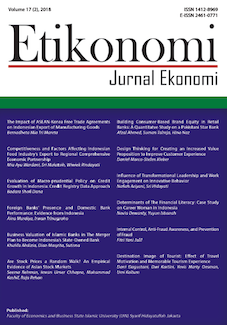The Impact of ASEAN-Korea Free Trade Agreements on Indonesian Export of Manufacturing Goods
DOI:
https://doi.org/10.15408/etk.v17i2.7342Keywords:
AKFTA, trade creation, trade diversion, gravity modelAbstract
Along with an attempt to promote the export performance of manufacturing goods, the number of investigation about the potential benefit or harm of free trade agreements is still weak in Indonesia. This paper highlights the effect of ASEAN-Korea Free Trade Agreement (AKFTA) on Indonesian export of manufacturing products since AKFTA as one of the significant initiatives in Southeast Asia is expected to boost Indonesian export. By using augmented gravity models with panel data, this paper investigates the presence of trade creation and trade diversion effects on Indonesian export with 20 trading partners, covering a 26-year period from 1990-2015. Fixed effects with least square dummy variable (LSDV) models are applied to tackle the endogeneity problems of FTA by controlling the unobserved heterogeneity. The results showed that trade diversion outweighs trade creation effects in almost all categories, confirming a decrease in export from member to non-member countries.
Downloads
References
Adam, C., & Cobham, D. (2007). Modelling multilateral trade resistance in a gravity model with exchange rate regimes. Centre for Dynamic Macroeconomic Analysis Conference Papers. Vol. 44: 1–49.
Agnosteva, D. E., Anderson, J. E., & Yotov, Y. V. (2014). Intra-national Trade Costs: Measurement and Aggregation. NBER Working Paper No. 19872. doi: https://doi.org/10.3386/w19872.
Baier, S. L., & Bergstrand, J. H. (2007). Do Free Trade Agreements Actually Increase Members’ International Trade? Journal of International Economics. Vol. 71 (1): 72-95. doi: https://doi.org/10.1016/j.jinteco.2006.02.005.
Carrère, C. (2006). Revisiting The Effects of Regional Trade Agreements on Trade Flows with Proper Specification of The Gravity Model. European Economic Review. Vol. 50(2): 223–247. doi: https://doi.org/10.1016/j.euroecorev.2004.06.001.
Cheng, I., & Wall, H. J. (2005). Controlling for Heterogeneity in Gravity Models of Trade and Integration. Federal Reserve Bank of St. Louis Review. Vol. 87(1): 49–63.
Devadason, E. S. (2010) ASEAN–China Trade Flows: Moving Forward with ACFTA. Journal of Contemporary China. Vol. 19 (66): 653-674. doi: https://doi.org/ 10.1080/10670564.2010.485403
Egger, P. H., & Nigai, S. (2015). Structural Gravity with Dummies Only: Constrained ANOVA-type Estimation of Gravity Models. Journal of International Economics. Vol. 97(1): 86-99. https://doi.org/10.1016/j.jinteco.2015.05.004
Elliott, R. J., & lkemoto, K. (2004). AFTA and the Asian Crisis: Help or Hindrance to ASEAN Intra-Regional Trade? Asian Economic Journal. Vol. 18 (1): 1-23. doi: https://doi.org/10.1111/j.1467-8381.2004.00179.x.
French, S. (2011). The Composition of Exports and Gravity. Working Paper. University of New South Wales.
Ha, Y. S., Chung, K. J., & Seo, J. S. (2016). An Analysis of Korea-ASEAN Trade and its Implications for the Shipping Industry in Korea. Asian Journal of Shipping and Logistics. Vol. 32(2): 63–71. doi: https://doi.org/10.1016/j.ajsl.2016.06.002
Heo, Y., & Kien, T. N. (2013). Korea-ASEAN Trade Flows and the Role of AFTA: Sector-Specific Evidence of Trade Diversion. Journal of International Logistics and Trade. Vol. 10(2): 21-45.
Jayasinghe, S., & Sarker, R. (2008). Effects of Regional Trade Agreements on Trade in Agrifood Products: Evidence from Gravity Modeling Using Disaggregated Data. Review of Agricultural Economics. Vol. 30(1): 61–81. doi: https://doi.org/10.1111/j.1467-9353.2007.00392.x
Jugurnath, B., Stewart, M., & Brooks, R. (2007). Asia/Pacific Regional Trade Agreements: An Empirical Study. Journal of Asian Economics. Vol. 18: 974-987. doi: https://doi.org/10.1016/j.asieco.2007.09.003.
Kahouli, B, & Maktouf, S. (2015). Trade Creation and Diversion effects in The Mediterranean Area: Econometric Analysis by Gravity Model. The Journal of International Trade & Economic Development. Vol. 24(1): 76-104. doi: https://doi.org/10.1080/09638199.2013.873479.
Kepaptsoglou, K., Karlaftis, M. G., & Tsamboulas, D. (2010). The Gravity Model Specification for Modeling International Trade Flows and Free Trade Agreement Effects: A 10-Year Review of Empirical Studies. The Open Economics Journal. Vol. 3(1): 1–13. doi: https://doi.org/10.2174/1874919401003010001
Kien, N. T. (2009). Gravity Model by Panel Data Approach; An Empirical Application with Implications for the ASEAN Free Trade Area. ASEAN Economic Bulletin. Vol. 26(3): 266–277. doi: https://doi.org/10.1355/ae26-3c.
Macphee, C. R., & Sattayanuwat, W. (2014). Consequence of Regional Trade Agreements to Developing Countries. Journal of Economic Integration. Vol. 29(1): 64-94. doi: https://doi.org/10.11130/jei.2014.29.1.64.
Magee, C. S. P. (2008). New Measures of Trade Creation and Trade Diversion. Journal of International Economics. Vol. 75: 349–362. doi: https://doi.org/10.1016/j.jinteco.2008. 03.006
Matyas, L. (1997). Proper Econometric Specification of The Gravity Model. The World Economy. Vol. 20: 262-302. doi: https://doi.org/10.1111/1467-9701-00074.
Narayan, S & Nguyen T. T. (2016). Does The Trade Gravity Model Depend on Trading Partners? Evidence from Vietnam and 54 Trading Partners. International Review of Economics and Finance. Vol. 41: 220–237. doi: https://doi.org/10.1016/j.iref.2015.08. 010.
Okabe, M., & Urata, S. (2014). The Impact of AFTA on Intra-AFTA Trade. Journal of Asian Economics. Vol. 35: 12–31. doi: https://doi.org/10.1016/j.asieco.2014.09.004
Olivero, M. P., & Yotov Y. V. (2012). Dynamic Gravity: Endogenous Country Size and Asset Accumulation. Canadian Journal of Economics/Revue canadienne d’économique. Vol. 45(1): 64-92. doi: 10.1111/j.1540-5982.2011.01687.x
Park, D., Park, I., & Estrada, G. E. B. (2008). Is the ASEAN-Korea Free Trade Area (AKFTA) an Optimal Free Trade Area? ADB Working Paper Series No. 21 on Regional Economic Integration.
Piermartini, R., & Yotov, Y. V. (2016). Estimating Trade Policy Effects with Structural Gravity. WTO Working Paper. Vol. (10): 1-63. doi: https://doi.org/10.1007/s10273-011-1262-2
Silva, J. M. C. S., & Tenreyro, S. (2006). The Log of Gravity. Review of Economics and Statistics. Vol. 88(4): 641–658. doi: https://doi.org/10.1162/rest.88.4.641
Soloaga, I., & Winters, L. A. (2001). Regionalism in the Nineties: What Effect on Trade? North American Journal of Economics and Finance. Vol. 12(1): 1-29. doi: http://doi.org/ 10.1016/S1062-9408(01)00042-0
Trotignon, J. (2016). Does Regional Integration Promote the Multilateralization of Trade Flows ? A Gravity Model Using Panel Data. Journal of Economic Integration. Vol. 25(2): 223-251.
Urata, S., & Okabe, M. (2014). Trade Creation and Diversion Effects of Regional Trade Agreements : A Product-level Analysis. The World Economy. Vol. 37 (2): 267-289. doi: https://doi.org/10.1111/twec.12099.
Yang, S., & Martinez-zarzoso, I. (2014). China Economic Review A Panel Data Analysis of Trade Creation and Trade Diversion Effects: The Case of ASEAN-China Free Trade Area. China Economic Review. Vol. 29: 138–151. doi: https://doi.org/j.chieco.2014.04. 002.
Zidi, A. & Dhifallah, S. M (2013). Trade Creation and Trade Diversion between Tunisia and EU: Analysis by Gravity Model. International Journal of Economics and Finance. Vol. 5(5): 131-147. doi: https://doi.org/10.5539/ijef.v5n5p131.










